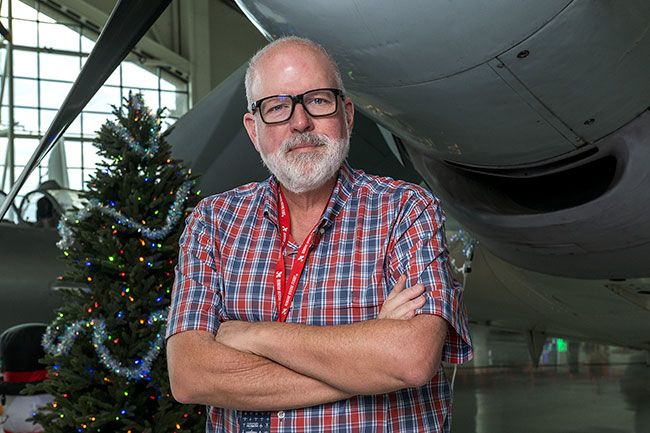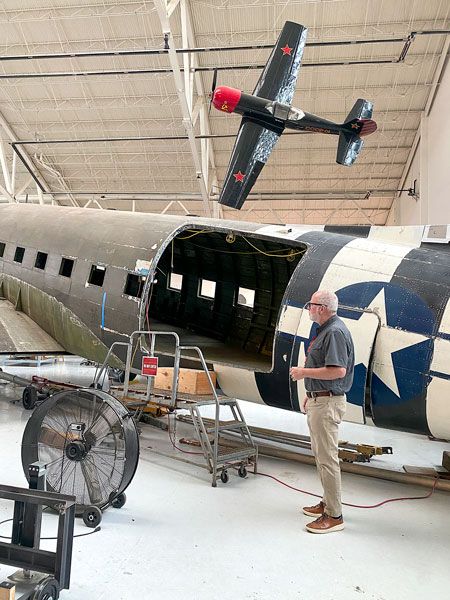Stopping By: Stories of flight


While he is intrigued by each plane in the Evergreen Aviation and Space Museum, CEO Scot Laney particularly loves the stories behind the aircraft.
Strolling through the aviation building’s restoration shop, easily visible beneath the tail of the Spruce Goose, Laney pauses to admire the work being done on a C-47. Volunteers are 10 months into a two-year project to return the big plane to World War II condition.
It’s not just any C-47, Laney said. The museum’s C-47 flew during Operation Market Garden, helping the Allies create a route by which to invade Germany. It landed three times at the Bergen-Belsen concentration camp to pick up emaciated and ill people as the camp was liberated; former prisoners gave the flight crew buttons and pebbles as a way of thanking them.
The museum’s C-47 also dropped paratroopers from the 101st Airborne Division into France on D-Day.
“Can you imagine,” Laney said as he peered into the plane’s exterior, now empty. “June 6, 1944, it was filled with about 40 scared to death 18- to 20-year-olds getting ready to jump?”
The warbird sits next to a shiny DC-3, the civilian name for the C-47. It, too, has a history: the very first DC-3 delivered to an airline, it flew passengers for United.
The two big planes, the Spruce Goose and dozens of other unique, rare and special aircraft and, across the parking lot, rockets and other aerospace exhibits, make the Evergreen museums “such a wonderful community asset,” Laney said.
He’s pleased to have become CEO in August. One of his goals is to attract more visitors from McMinnville and Yamhill County. If local people don’t take advantage of seeing a world-class museum in their backyard, they’re missing out, he said.
“Who else has this?” he asked “This is pretty neat.”
Laney, of Newberg, was already very familiar with the Evergreen Aviation and Space Museum before he became CEO. He had been a board member for about two years.
“I had a friend on the board,” he said, explaining how he came to join the organization after retiring from managing his own company. “The institution attracted me.”
As a board member, he said, he was concerned that the museum had gone through a period of instability when the land was owned by two different landlords following the 2014 death of founder Del Smith. One landlord even sold off some of the planes that had been on display.
Now, however, he is pleased that Bill Stoller of the Stoller Group and McMinnville Properties is the landlord for the entire museum campus, including his for-profit event businesses and the nonprofit, educational museums.
“A great outcome,” he said. “We’re now stable under Stoller.”
When the museum’s former CEO departed in spring, the board discussed requirements for the job. His fellow members suggested he take the position.
“I was more than happy to. Who gets to do this?” he said. “It’s a privilege to be selected.”
As CEO, Laney oversees $4 billion worth of historic aircraft, aerospace vehicles and other exhibits, including one-of-a-kind planes such as the Spruce Goose. He also is in charge of staffing, purchasing, budgeting and other daily tasks.
But what makes the position so special, he said, are the “300 very passionate people” who are involved with the museums, including restoration workers, collections staff and volunteer docents who’ve flown or worked on the aircraft or have other stories to tell about history,
He said he loves listening to their stories. “I learn things every day,” he said.
For instance, Thursday docent Max Dixon flew A-4s. He has told Laney about his missions flying and landing on aircraft carriers, and about the plane’s nuances.
Many other volunteers have told him about their experiences. “It’s a privilege to talk to them,” he said. “And every docent is like that.”
With passionate volunteers and employees combined with the exhibits, “this is a significant asset for our community,” he said. “People come from all over the state, the nation, the world.”
Since he took over in August, he said, the museum has welcomed visitors from 17 countries, including Russia, New Zealand, Brazil and Australia. “They all come to see the Spruce Goose, the SR-71, the F-17, the rockets” and other favorites, he said.
Their visits benefit the community at large, Laney said. “They stay here, eat here, go wine tasting, go shopping …”
Museum staff regularly provide information about other things to do in McMinnville and Yamhill County. “We encourage them to do more,” he said.
They also encourage them to make use of other offerings owned by the Stoller Group on the same campus – plan a wedding or another event (a new, larger event center is almost finished), splash at the Wings and Waves Water Park, see movies on the largest screen in Oregon. In the near future, he said, the Stoller Group will add a hotel that will provide more lodging space in the area.
Seventy percent of visitors come from out of the county. Seventy-five percent of members are from outside the county, many of them from other states or countries.
While Laney is pleased to attract people from far away, he said he wants to bring in more locals.
They really should take advantage of a world-class attraction that’s in their backyard.
“It’s very unusual to have such a museum in a low-density area like this,” he said, noting that most major air museums are in big cities such as Washington, D.C., or London.
Yet the museum in McMinnville is ranked higher than many larger, urban facilities; higher than the British Air Force museum, for instance, and on par with the Smithsonian.
Evergreen is affiliated with the Smithsonian, in fact. “That means they will share their treasures with us,” he said.
The local museum also has spacecraft from the Cosmodrome, NASA Jet Propulsion Laboratory, the U.S. Museum of the Air Force, and NASA.
“We’re well-positioned” to get rare and unusual aircraft, he said.
For instance, he said, F-17 Stealth Fighters are hard to obtain. “But we have one!”
Similarly, he said, few SR-71s exist, and “there are very, very few you can actually access.” But one of them is here.
Laney said it’s also a rare thing to have a restoration shop visible to the public.
“We’re the only one that does restoration on the floor of the museum,” he said. “We want people to see the process of bringing part of our history back to life.”
As much as he appreciates the planes for their own sake, Laney said, he is most interested in “the stories, the parallels to history.” The stories behind the aircraft intrigue him.
The Wright Flyer, for instance, is represented by a replica in the Evergreen museum. It was developed by “two guys building bicycles and talking about how birds control their flight,” Laney marveled. “Two brothers having a chat over lunch, and it became an obsession.”
He’s also intrigued by how the brothers, who pioneered controlled flight, also had their limits. So it was Glenn Curtiss, a trained engineer, who took what the Wright Brothers started and moved aviation forward by bringing in new ideas.
When Laney has a chance to lead tours of the museum, he talks about things like that — “about the human condition.”
The tales of planes and people “is the story of America and how we learn from our mistakes,” he said.
His favorite aircraft is the Skyraider. “It’s so big and chunky, so rugged; it doesn’t look like it could fly,” he said of the plane, used mostly in the Korean and Vietnam war eras. “It was built to do one thing, and it did it well.”
He called the Skyraider “the dad of the A-10,” a jet fighter that’s his second-favorite aircraft.
He likes to tell a story about the relatively slow prop-driven Skyraider being attacked by jet-powered MIGs. Pilots realized the MIGS couldn’t slow down, so they forced them into confronting the heavily armored Skyraiders head-on, winning the battles.
Laney is an advocate for education, one of the Evergreen museum’s missions, and for community involvement.
In 2025, he looks forward to job shadows, four weeks of summer camps, numerous field trips and other programs that not only educate, but may spark an interest in aviation careers.
“There’s room in aviation for everybody. Good-wage jobs,” he said. “The aviation industry is looking for people.”
For instance, he said, Horizon Airlines will pay for training the right job candidates. “Not everyone has to be an engineer or go to college first,” he said.
Many youngsters are introduced to the museum through school field trips or summer camps.
The museum hosts McMinnville School District science experiences. It also provides space for organizations such as Cub Scouts, which will have its pinewood derby there Jan. 18.
Laney recalled racing in the pinewood derby himself when he was a youngster. “Cub Scouting teaches kids to be organized and make friends,” he said.
Other people learn about the museum through community activities, such as the UFO Festival parade, the McMinnville Area Chamber of Commerce Greeters events, or the annual Goose Lights holiday light show, in which businesses and organizations decorate aircraft.
Locals also may come to the museum to hear notable speakers, from astronauts to experts in aviation and space exploration.
The museum also attracts people with “community days,” when various charitable organizations receive half the admission proceeds. The organizations also get to set up displays to show visitors about what they do.
Nonprofits such as the Court Appointed Special Advocates Program, PEO and With Courage have benefited in recent months.
With Courage, which helps breast cancer patients, has another day scheduled Feb. 8. The See Ya Later Foundation will be the recipient of a community day on Feb 15, and Feb. 22 will be devoted to Cast for Kids, which takes special needs children fishing.
He is hoping to see local residents turn out for community days, as well as visiting the museum throughout the year.
“That’s about helping to support their good work,” Laney said. “Supporting local organizations and seeing a world-class museum.”
Through the community days program, he added, “I’ve met some of the coolest people through this, like PEO, an absolutely wonderful women’s education organization.”
Since being named museum CEO, Laney has spoken at a PEO meeting. He also plans to visit retirement homes and other places to “let people know we’re here.”
He said he is available to speak to other organizations, as well.
Before the air museum, Laney led a diverse life
Evergreen Museum CEO Scot Laney wasn’t born to aviation. He grew up on a farm in Beaverton and raised his children there. Then, seeking more space than urbanized Beaverton offered, he and his wife moved to Newberg.
“I’m more of a rural person,” he said, noting that 14 generations of his paternal family were farmers; his mother also came from a farm.
His own career was far from agricultural, though: He ran a company that made industrial polymers. He still is co-owner of the business, which makes rubber products for use in heavy-duty agricultural and trucking equipment, school buses and Class A motorhomes.
Before that, he was in law enforcement, starting as an officer in Reno, Nevada. He called the job “fun and busy” at a “very progressive” police department. “It gave me a better understanding of community,” he said.
He had enrolled in the University of Nevada to study criminal justice, thinking he would go to law school. But he realized law enforcement fit his interests better.
Laney trained as a hostage negotiator. The training at the FBI Academy has served him well in other capacities, he said, including his present job.
“You learn to listen; that everything can’t be the end of the world; you learn to take in a situation quickly,” he said.
He would like to see such training offered to laypeople, as well, he said.








Comments
Moe
"It’s not just any C-47, Laney said. The museum’s C-47 flew during Operation Market Garden, helping the Allies create a route by which to invade Germany."
A disastrous operation in itself, by British General Montgomery. Made possible by Eisenhower cutting General Patton's gasoline, the bigger disaster - for at the time, Patton was chasing the Germans, in headlong retreat, back into Germany, with the war plausibly ending by Thanksgiving 1944, saving so many lives (including avoiding the Battle of the Bulge), and with the Russians still in Russia.
"The museum’s C-47 also dropped paratroopers from the 101st Airborne Division into France on D-Day."
An unnecessary, or at least much more costly operation than necessary - as Europe had already been successfully invaded, at great cost, by the largely unexploited allied invasion of Italy, Rome liberated 4 June 1944, two days before D-Day.
Similar comments apply to the Pacific war.
Moe
See:
"Gasoline to Patton," by Brigadier General (RET.) Albin F. Irzyk, 2005.
(General Irzyk was a 27/28 year old Battalion Tank Commander in the 4th Armored Division with Patton's Third Army.)
"American Betrayal," by Diana West, 2013.
Information from sources such as above could be included with the exhibits. That would serve to really inform people, and provide a context, beyond a plane flying on such and such a mission, and be honoring to all of our veterans.
Otis
What a fantastic museum that we have here in town! So glad we call this place home!